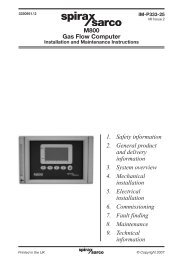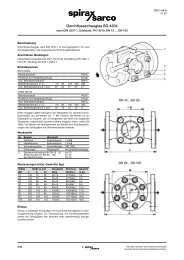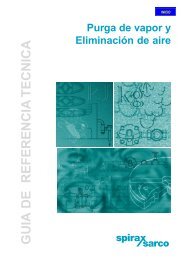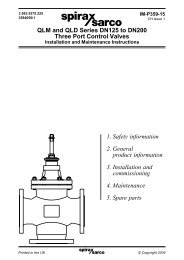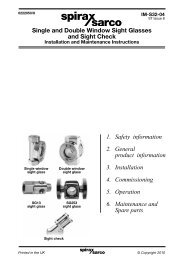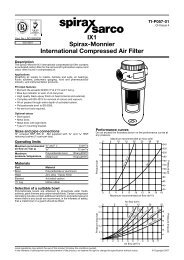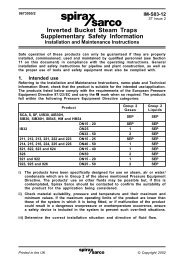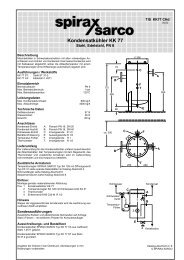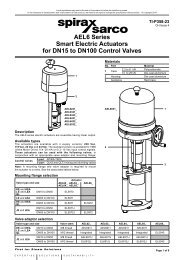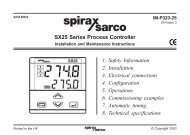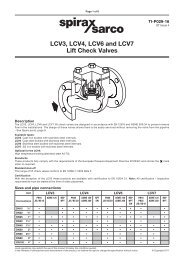2000 Hook-up Book - Spirax Sarco
2000 Hook-up Book - Spirax Sarco
2000 Hook-up Book - Spirax Sarco
Create successful ePaper yourself
Turn your PDF publications into a flip-book with our unique Google optimized e-Paper software.
SYSTEM DESIGN<br />
56<br />
Testing Steam Traps<br />
What must be done, using all<br />
audible and visual clues, is to<br />
detect normal or abnormal<br />
cycling of the discharge. Even<br />
this method is very fallible, since<br />
the mode of operation of different<br />
trap types if not nearly so well<br />
defined as is sometimes thought.<br />
Table 16 lists some of the possibilities<br />
and allows the problem to<br />
be seen more clearly.<br />
It is seen that the “signal” to be<br />
obtained from the trap, whether<br />
visual, audio or temperature, is<br />
usually going to be so ambiguous<br />
as to rely largely on optimism for<br />
interpretation. The one trap which<br />
is fairly positive in its action is the<br />
disc thermodynamic type—if this<br />
is heard or seen to cycle <strong>up</strong> to ten<br />
times per minute, it is operating<br />
normally. The cycling rate increases<br />
when the trap becomes worn<br />
and the characteristic “machine<br />
gun” sound clearly indicates the<br />
need for remedial action.<br />
Spira-tec Leak Detector<br />
System<br />
Logic says that if it is not possible<br />
to have a universally applicable<br />
method of checking steam traps<br />
by examining the traps themselves,<br />
then we must see if it can<br />
be done by checking elsewhere.<br />
This is what <strong>Spirax</strong> <strong>Sarco</strong> has<br />
done with the Spira-tec system.<br />
See Fig. 61 (page 58).<br />
The Spira-tec detector chamber<br />
is fitted into the condensate<br />
Table 16: Steam Trap Discharge Modes<br />
Mode of Operation<br />
Full or Usual<br />
Trap Type No Load Light Load Normal Load Overload Failure Mode<br />
Float & Usually continuous but may Closed,<br />
Thermosatic No Action cycle at high pressure Continuous A.V. Open<br />
Inverted Bucket<br />
Balanced Pressure<br />
Small Dribble Intermittent Intermittent Continuous Open<br />
Thermostatic No Action May Dribble Intermittent Continuous Variable<br />
Bimetallic Usually Dribble May blast at<br />
Thermostatic No Action Action high pressures Continuous Open<br />
Impulse<br />
Disc<br />
Small Dribble<br />
Usually continuous<br />
with blast at high loads Continuous Open<br />
Thermo-Dynamic No Action Intermittent Intermittent Continuous Open<br />
line on the inlet side of the trap. If<br />
there is, at this point, a normal flow<br />
of condensate towards the trap,<br />
together with a small amount of air<br />
and the steam needed to make <strong>up</strong><br />
heat loss from the body of the<br />
steam trap, then all is normal. On<br />
the other hand, an increased flow<br />
of gas along the pipe indicates<br />
that the trap is leaking.<br />
The chamber contains an<br />
inverted weir. Condensate flows<br />
under this weir and a small hole<br />
at the top equalizes the pressure<br />
on each side when the steam trap<br />
is working normally. An electrode<br />
on the <strong>up</strong>stream side of the baffle<br />
detects the presence of condensate<br />
by its conductivity which is<br />
much higher than that of steam.<br />
By plugging in the portable indicator,<br />
it is possible to check if the<br />
electrical circuit is complete when<br />
a visual signal indicates that the<br />
trap is working.<br />
If the trap begins to leak<br />
steam, then the pressure on the<br />
downstream side of the weir<br />
begins to fall. The higher pressure<br />
on the <strong>up</strong>stream side drops the<br />
condensate level below the electrode<br />
and exposes it to steam.<br />
The “conductivity” circuit is broken<br />
and the indicator light gives a<br />
“fail” signal.<br />
The advantage of the system<br />
lies in the very positive signal<br />
which does not require experience<br />
of personal judgement<br />
before it can be interpreted.<br />
Using suitable wiring, the test<br />
point can be located remote from<br />
the sensor chamber or it can<br />
have a multi switch to allow <strong>up</strong> to<br />
twelve (12) chambers to be<br />
checked from a single test location.<br />
When appropriate, an<br />
electronic continuous 16-way<br />
checking instrument can monitor<br />
the chambers and this is readily<br />
connected into a central Energy<br />
Management System.<br />
The object of detecting leaking<br />
steam traps is to correct the<br />
problem. This can mean replacement<br />
of the whole trap, or<br />
perhaps of the faulty part of the<br />
internal mechanism. It is very<br />
useful indeed to be able to check<br />
a repaired trap in the workshop<br />
before it is installed in the line,<br />
and many repair shops now use a<br />
Spira-tec chamber as part of a<br />
bench test rig. The diagram<br />
shows a simple hook<strong>up</strong> which<br />
allows suspect or repaired traps<br />
to be positively checked. (Fig. 60)<br />
Cost Of Steam Leaks<br />
The installation and use of the<br />
Spira-tec units does involve some<br />
cost, and it is necessary to compare<br />
this with the cost of steam<br />
leakages to see if the expenditure<br />
is economically justifiable. Since<br />
all equipment must wear and<br />
eventually fail, we need first an<br />
estimate of the average life of a<br />
steam trap. Let us assume that in<br />
a particular installation, this is,



